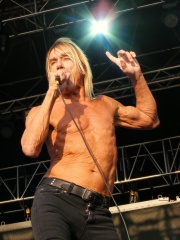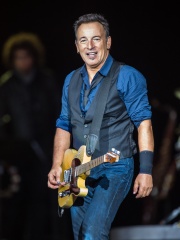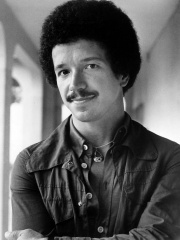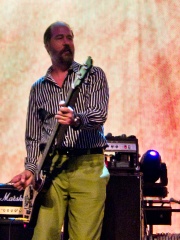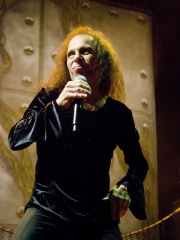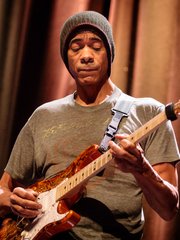
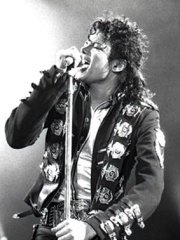
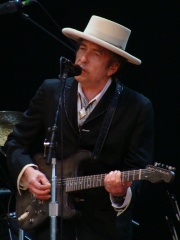
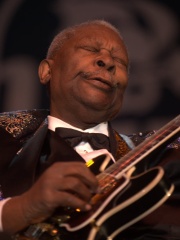
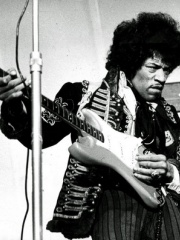
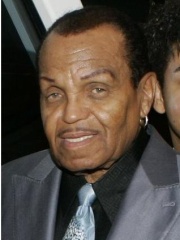
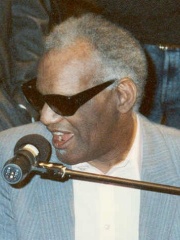
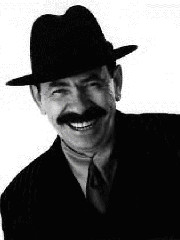
The Most Famous
MUSICIANS from United States
This page contains a list of the greatest American Musicians. The pantheon dataset contains 3,175 Musicians, 1,445 of which were born in United States. This makes United States the birth place of the most number of Musicians.
Top 10
The following people are considered by Pantheon to be the top 10 most legendary American Musicians of all time. This list of famous American Musicians is sorted by HPI (Historical Popularity Index), a metric that aggregates information on a biography's online popularity. Visit the rankings page to view the entire list of American Musicians.

1. Madonna (b. 1958)
With an HPI of 85.74, Madonna is the most famous American Musician. Her biography has been translated into 153 different languages on wikipedia.
Madonna Louise Ciccone ( chih-KOH-nee; born August 16, 1958) is an American singer, songwriter, record producer, and actress. Dubbed the "Queen of Pop", she is regarded as a cultural icon spanning both the 20th and 21st centuries. She is known for her continual reinvention and versatility in music production, songwriting, and visual presentation, with works that incorporate social, political, sexual, and religious themes and have generated both controversy and critical acclaim. Madonna is often deemed one of the greatest entertainers in the history of popular music. Madonna moved to New York City in 1978 to pursue a career in dance. After performing as a drummer, guitarist, and vocalist in the rock bands Breakfast Club and Emmy, she rose to solo stardom with her debut studio album, Madonna (1983). She has since earned eighteen multi-platinum albums, including Like a Virgin (1984), True Blue (1986), and The Immaculate Collection (1990)—some of the best-selling albums of all time—and Confessions on a Dance Floor (2005), her 21st-century bestseller. Like a Prayer (1989), Ray of Light (1998), and Music (2000) were ranked among Rolling Stone's greatest albums of all time. Madonna's top-charting singles include "Like a Virgin", "Material Girl", "La Isla Bonita", "Like a Prayer", "Vogue", "Take a Bow", "Frozen", "Music", "Hung Up", and "4 Minutes". Madonna has starred in films such as Desperately Seeking Susan (1985), Dick Tracy (1990), A League of Their Own (1992), and Evita (1996), with the lattermost winning her a Golden Globe Award for Best Actress. Many of her other films were not well-received. Her business endeavors encompass the company Maverick (1992–2009), which included Maverick Records—one of the most successful artist-run labels. She has also pursued fashion brands, written works, health clubs, and filmmaking. She contributes to various charities, having founded the Ray of Light Foundation in 1998 and Raising Malawi in 2006, and advocates for gender equality and LGBT rights. Madonna is the best-selling female music artist of all time and the first female performer to accumulate US$1 billion from her concerts. She is the most successful solo artist on the US Billboard Hot 100 and has 44 number-one singles across major global music markets. Her accolades include seven Grammy Awards, two Golden Globe Awards, 20 MTV Video Music Awards, and an induction into the Rock and Roll Hall of Fame in her first year of eligibility. Madonna was the world's highest-paid female musician for a record eleven years across four decades (1980s–2010s). She has become the subject of various scholarly, literary, and artistic works, as well as a mini-academic sub-discipline called Madonna studies.

2. Michael Jackson (1958 - 2009)
With an HPI of 85.12, Michael Jackson is the 2nd most famous American Musician. His biography has been translated into 279 different languages.
Michael Joseph Jackson (August 29, 1958 – June 25, 2009) was an American singer, songwriter, dancer, and philanthropist. Dubbed the "King of Pop", he is widely regarded as one of the most culturally significant figures of the 20th century. Over a four-decade career, his musical achievements broke American racial barriers and made him a dominant figure worldwide. Through his songs, concerts, and fashion, he proliferated visual performance for artists in popular music, popularizing street dance moves such as the moonwalk, the robot, and the anti-gravity lean. Jackson is often deemed the greatest entertainer of all time. The eighth child of the Jackson family, Michael made his public debut at age six as the lead singer of the Jackson 5, one of Motown's most successful acts. He rose to solo stardom with the album Off the Wall (1979) and achieved unprecedented global success with Thriller (1982), the best-selling album in history. Its short film-style music videos for "Thriller", "Beat It", and "Billie Jean" redefined the medium as an art form. Jackson followed it with Bad (1987), the first album to produce five US Billboard Hot 100 number-one singles: "I Just Can't Stop Loving You", "Bad", "The Way You Make Me Feel", "Man in the Mirror", and "Dirty Diana". Dangerous (1991) and HIStory (1995) explored socially conscious themes, and Invincible (2001) became one of the best-selling albums of the 21st century. From the mid-1980s, Jackson came under public scrutiny due to changes in his appearance, relationships, behavior, and lifestyle. He was accused of sexually abusing the child of a family friend in 1993. In 2005, Jackson was tried and acquitted of further such allegations and other charges. In 2009, while preparing for This Is It, a series of comeback concerts, he died from an overdose of propofol administered by his personal physician Conrad Murray, who was convicted of involuntary manslaughter in 2011. Jackson's death triggered global reactions, creating unprecedented surges of internet traffic and a spike in his music sales. His televised memorial service, held at the Staples Center in Los Angeles, is estimated to have been viewed by more than 2.5 billion people. Jackson is one of the best-selling music artists of all time, with estimated sales of over 500 million records. He holds a joint-record for a male solo artist with 13 Billboard Hot 100 number-one singles and is the only artist to have a top-ten single in six decades. One of the most-awarded music artists in history, Jackson received 13 Grammy Awards, the Grammy Legend Award, and the Grammy Lifetime Achievement Award; 26 American Music Awards; 12 World Music Awards; eight MTV Video Music Awards; six Brit Awards; and three presidential honors. He was inducted into numerous halls of fame, including the Rock and Roll Hall of Fame twice, the Songwriters Hall of Fame, and the Dance Hall of Fame. Having donated an estimated $500 million, Jackson is credited with setting a standard for celebrity charity. In 2024, half of his music catalogue was sold to Sony for $600 million, the largest music acquisition for a single artist.

3. Bob Dylan (b. 1941)
With an HPI of 82.73, Bob Dylan is the 3rd most famous American Musician. His biography has been translated into 143 different languages.
Bob Dylan (legally Robert Dylan; born Robert Allen Zimmerman, May 24, 1941) is an American singer-songwriter. Described as one of the greatest songwriters of all time, Dylan has been a major figure in popular culture over his 68-year career. With an estimated 125 million records sold worldwide, he is one of the best-selling musicians. Dylan added increasingly sophisticated lyrical techniques to the folk music of the early 1960s, infusing it "with the intellectualism of classic literature and poetry". His lyrics incorporated political, social, and philosophical influences, defying pop music conventions and appealing to the burgeoning counterculture. Dylan was born in St. Louis County, Minnesota. He moved to New York City in 1961 to pursue a music career. His 1962 debut album, Bob Dylan, containing traditional folk and blues material, was followed by his breakthrough album, The Freewheelin' Bob Dylan (1963), which included "Girl from the North Country" and "A Hard Rain's a-Gonna Fall", adapting older folk songs. His songs "Blowin' in the Wind" (1963) and "The Times They Are a-Changin'" (1964) became anthems for the civil rights and antiwar movements. In 1965 and 1966, Dylan created controversy when he used electrically amplified rock instrumentation for his albums Bringing It All Back Home, Highway 61 Revisited (both 1965), and Blonde on Blonde (1966). His six-minute single "Like a Rolling Stone" (1965) expanded commercial and creative boundaries in popular music. After a motorcycle crash in 1966, Dylan ceased touring for seven years. During this period, he recorded a large body of songs with members of the Band, which produced the album The Basement Tapes (1975). Dylan explored country music and rural themes on the albums John Wesley Harding (1967), Nashville Skyline (1969), and New Morning (1970). He gained acclaim for Blood on the Tracks (1975) and Time Out of Mind (1997), the latter of which earned him the Grammy Award for Album of the Year. Dylan still releases music and has toured continually since the late 1980s on what has become known as the Never Ending Tour. Since 1994, Dylan has published ten books of paintings and drawings, and his work has been exhibited in major art galleries. His life has been profiled in several films, including the biopic A Complete Unknown (2024). Dylan's accolades include an Academy Award and ten Grammy Awards. He was honored with Kennedy Center Honors in 1997 and the Presidential Medal of Freedom in 2012. Dylan has been inducted into the Rock and Roll Hall of Fame and the Songwriters Hall of Fame. He was awarded a Pulitzer Prize special citation in 2008, and the 2016 Nobel Prize in Literature "for having created new poetic expressions within the great American song tradition".

4. B.B. King (1925 - 2015)
With an HPI of 81.79, B.B. King is the 4th most famous American Musician. His biography has been translated into 83 different languages.
Riley B. King (September 16, 1925 – May 14, 2015), known professionally as B. B. King, was an American blues guitarist, singer, songwriter, and record producer. He introduced a sophisticated style of soloing based on fluid string bending, shimmering vibrato, and staccato picking that influenced many later electric guitar blues players. AllMusic recognized King as "the single most important electric guitarist of the last half of the 20th century". He was inducted into the Rock and Roll Hall of Fame in 1987 and is one of the most influential blues musicians in history, earning the nickname "The King of the Blues", and is referred to as one of the "Three Kings of the Blues Guitar" (along with Albert King and Freddie King, none of whom are related). King performed tirelessly throughout his musical career, appearing on average at more than 200 concerts a year into his 70s. In 1956 alone, he appeared at 342 shows. Born and raised in the Mississippi Delta, he was attracted to music and taught himself to play guitar, beginning his career in juke joints and on local radio. King later lived and performed in Memphis and Chicago. As his fame grew, he toured the world extensively.
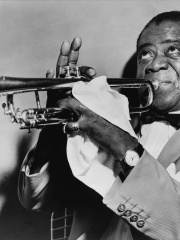
5. Louis Armstrong (1901 - 1971)
With an HPI of 80.57, Louis Armstrong is the 5th most famous American Musician. His biography has been translated into 142 different languages.
Louis Daniel Armstrong (August 4, 1901 – July 6, 1971), nicknamed "Satchmo", "Satch", and "Pops", was an American jazz and blues trumpeter and vocalist. He was among the most influential figures in jazz. His career spanned five decades and several eras in the history of jazz. Armstrong received numerous accolades including the Grammy Award for Best Male Vocal Performance for Hello, Dolly! in 1965, as well as a posthumous win for the Grammy Lifetime Achievement Award in 1972. His influence crossed musical genres, with inductions into the DownBeat Jazz Hall of Fame, the Rock and Roll Hall of Fame, and the National Rhythm & Blues Hall of Fame, among others. Armstrong was born and raised in New Orleans. Coming to prominence in the 1920s as an inventive trumpet and cornet player, he was a foundational influence in jazz, shifting the focus of the music from collective improvisation to solo performance. Around 1922, Armstrong followed his mentor, Joe "King" Oliver, to Chicago to play in Oliver's Creole Jazz Band. Armstrong earned a reputation at "cutting contests", and his fame reached band leader Fletcher Henderson. Armstrong moved to New York City, where he became a featured and musically influential band soloist and recording artist. By the 1950s, Armstrong was an international musical icon, appearing regularly in radio and television broadcasts and on film. Apart from his music, he was also beloved as an entertainer, often joking with the audience and keeping a joyful public image at all times. Armstrong's best known songs include "What a Wonderful World", "La Vie en Rose", "Hello, Dolly!", "On the Sunny Side of the Street", "Dream a Little Dream of Me", "When You're Smiling" and "When the Saints Go Marching In". He collaborated with Ella Fitzgerald, producing three records together: Ella and Louis (1956), Ella and Louis Again (1957), and Porgy and Bess (1959). He also appeared in films such as A Rhapsody in Black and Blue (1932), Cabin in the Sky (1943), High Society (1956), Paris Blues (1961), A Man Called Adam (1966), and Hello, Dolly! (1969). With his instantly recognizable, rich, gravelly voice, Armstrong was also an influential singer and skillful improviser. He was also skilled at scat singing. By the end of Armstrong's life, his influence had spread to popular music. He was one of the first popular African-American entertainers to "cross over" to wide popularity with white and international audiences. Armstrong rarely publicly discussed racial issues, sometimes to the dismay of fellow black Americans, but took a well-publicized stand for desegregation in the Little Rock crisis. He could access the upper echelons of American society at a time when this was difficult for black men.

6. Jimi Hendrix (1942 - 1970)
With an HPI of 79.33, Jimi Hendrix is the 6th most famous American Musician. His biography has been translated into 110 different languages.
James Marshall "Jimi" Hendrix (born Johnny Allen Hendrix; November 27, 1942 – September 18, 1970) was an American guitarist, singer, and songwriter. He is widely regarded as one of the greatest and most influential guitarists of all time. Inducted into the Rock and Roll Hall of Fame in 1992 as a part of his band, the Jimi Hendrix Experience, the institution describes him as "arguably the greatest instrumentalist in the history of rock music". Hendrix began playing guitar at age 15. In 1961, he enlisted in the US Army, but was discharged the following year. Soon afterward, he moved to Clarksville, then Nashville, Tennessee, and began playing gigs on the Chitlin' Circuit, earning a place in the Isley Brothers' backing band and later with Little Richard, with whom he continued to work through mid-1965. He then played with Curtis Knight and the Squires. Hendrix moved to England in late 1966, after bassist Chas Chandler of the Animals became his manager. Within months, he had formed his band, the Jimi Hendrix Experience (with its rhythm section consisting of bassist Noel Redding and drummer Mitch Mitchell), and achieved three UK top ten hits: "Hey Joe", "Purple Haze", and "The Wind Cries Mary". He achieved fame in the US after his performance at the Monterey Pop Festival in 1967. His third and final studio album, Electric Ladyland (1968), became his most commercially successful release and his only number one album on the US Billboard 200 chart. The world's highest-paid rock musician, Hendrix headlined the Woodstock Festival in 1969 and the Isle of Wight Festival in 1970. He died in London from barbiturate-related asphyxia in September 1970, at the age of 27. Hendrix was inspired by American rock and roll and electric blues. He favored overdriven amplifiers with high volume and gain, and was instrumental in popularizing the previously undesirable sounds caused by guitar amplifier feedback. He was also one of the first guitarists to make extensive use of tone-altering effects units in mainstream rock, such as fuzz distortion, Octavia, wah-wah, and Uni-Vibe. He was the first musician to use stereophonic phasing effects in recordings. Rolling Stone commented: "Hendrix pioneered the use of the instrument as an electronic sound source. Players before him had experimented with feedback and distortion, but Hendrix turned those effects and others into a controlled, fluid vocabulary every bit as personal as the blues with which he began."

7. Joe Jackson (1928 - 2018)
With an HPI of 76.31, Joe Jackson is the 7th most famous American Musician. His biography has been translated into 36 different languages.
Joseph Walter Jackson (July 26, 1928 – June 27, 2018) was an American talent manager and patriarch of the Jackson family of entertainers. He was inducted into the Rhythm and Blues Music Hall of Fame in 2014.

8. Ray Charles (1930 - 2004)
With an HPI of 76.30, Ray Charles is the 8th most famous American Musician. His biography has been translated into 87 different languages.
Ray Charles Robinson (September 23, 1930 – June 10, 2004) was an American singer, songwriter, and pianist. He is regarded as one of the most iconic and influential musicians of the 20th century and was often referred to by contemporaries as "The Genius". Among friends and fellow musicians, he preferred being called "Brother Ray". Charles was blinded during childhood, possibly due to glaucoma, and consequently wore dark glasses. Charles pioneered the soul music genre during the 1950s by combining elements of blues, jazz, rhythm and blues, and gospel into his music during his time with Atlantic Records. He contributed to the integration of country music, rhythm and blues, and pop music during the 1960s with his crossover success on ABC Records, notably with his two Modern Sounds albums. With ABC, Charles became one of the first black musicians to be granted artistic control by a mainstream record company. Charles' 1960s hit "Georgia on My Mind" was the first of his three career No. 1 hits on the Billboard Hot 100. His 1962 album Modern Sounds in Country and Western Music became his first album to top the Billboard 200. Charles had multiple singles reach the Top 40 on various Billboard charts: 61 on the US R&B singles chart, 33 on the Hot 100 singles chart, and eight on the Hot Country singles charts. Charles cited Nat King Cole as a primary influence, but was also influenced by Art Tatum, Louis Jordan and Charles Brown. He had a lifelong friendship and occasional partnership with Quincy Jones. Frank Sinatra called Ray Charles "the only true genius in show business", although Charles downplayed this notion. Billy Joel said, "This may sound like sacrilege, but I think Ray Charles was more important than Elvis Presley." For his musical contributions, Charles received the Kennedy Center Honors, the National Medal of Arts, and the Polar Music Prize. He was one of the inaugural inductees at the Rock and Roll Hall of Fame in 1986. He has won 17 Grammy Awards (five posthumously), the Grammy Lifetime Achievement Award in 1987, and ten of his recordings have been inducted into the Grammy Hall of Fame. Rolling Stone ranked Charles No. 10 on their list of the "100 Greatest Artists of All Time", and No. 2 on their list of the "100 Greatest Singers of All Time". In 2023, in its revised list for the "200 Greatest Singers of All Time", Charles was replaced at the No. 2 position by Whitney Houston while taking the sixth spot. In 2022, he was inducted into the Country Music Hall of Fame, as well as the Black Music & Entertainment Walk of Fame.

9. Scatman John (1942 - 1999)
With an HPI of 75.82, Scatman John is the 9th most famous American Musician. His biography has been translated into 47 different languages.
John Paul Larkin (March 13, 1942 – December 3, 1999), known professionally under the alias Scatman John, was an American musician. A prolific jazz pianist and vocalist for several decades, he rose to prominence in 1994 through his fusion of scat singing and dance music. He recorded five albums, which were released between 1986 and 2001. In the United States and Europe, Larkin is recognized for his singles "Scatman (Ski-Ba-Bop-Ba-Dop-Bop)" and "Scatman's World". He achieved his greatest success in Japan, where his album Scatman's World (1995) sold over a million copies. Outside of his musical activities, he had deepened exchanges with stuttering organizations and established the Scatland Foundation in 1996 with the purpose of furthering research of and educating the public on stuttering. Larkin was a recipient of the American Speech–Language–Hearing Association's Annie Glenn Award for outstanding service to the stuttering community and a posthumous inductee to the National Stuttering Association Hall of Fame.
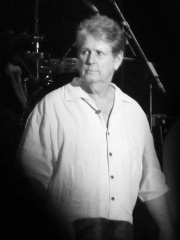
10. Brian Wilson (1942 - 2025)
With an HPI of 75.80, Brian Wilson is the 10th most famous American Musician. His biography has been translated into 44 different languages.
Brian Douglas Wilson (June 20, 1942 – June 11, 2025) was an American musician, singer, songwriter and record producer who co-founded the Beach Boys and received widespread recognition as one of the most innovative and significant musical figures of his era. His work was distinguished for its high production values, complex harmonies and orchestrations, vocal layering, and introspective or ingenuous themes. He was also known for his versatile head voice and falsetto. Wilson's formative influences included George Gershwin, the Four Freshmen, Phil Spector, and Burt Bacharach. In 1961, he began his professional career as a member of the Beach Boys, serving as the band's songwriter, producer, co-lead vocalist, bassist, keyboardist, and de facto leader. After signing with Capitol Records in 1962, he became the first pop musician credited for writing, arranging, producing, and performing his own material. He also produced acts such as the Honeys and American Spring. By the mid-1960s he had written or co-written more than two dozen U.S. Top 40 hits, including the number-ones "Surf City" (1963), "I Get Around" (1964), "Help Me, Rhonda" (1965), and "Good Vibrations" (1966). He is considered the first rock producer to apply the studio as an instrument and one of the first music producer auteurs. Facing lifelong struggles with mental illness, Wilson had a nervous breakdown in late 1964 and subsequently withdrew from regular concert touring to focus on songwriting and production. This resulted in works of greater sophistication, such as the Beach Boys' Pet Sounds and his first credited solo release, "Caroline, No" (both 1966), as well as the unfinished album Smile. Branded a genius, by the late 1960s, his productivity and mental health had significantly declined, leading to periods marked by reclusion, overeating, and substance abuse. His first professional comeback yielded the almost solo effort The Beach Boys Love You (1977). In the 1980s, he formed a controversial creative and business partnership with his psychologist, Eugene Landy, and relaunched his solo career with the album Brian Wilson (1988). Wilson dissociated from Landy in 1991 and toured regularly from 1999 to 2022. He completed a version of Smile in 2004, earning him his greatest acclaim as a solo artist. Heralding popular music's recognition as an art form, Wilson's accomplishments as a producer and composer helped initiate an era of unprecedented creative autonomy for label-signed acts. He contributed to the development of many music genres and movements, including the California sound, art pop, psychedelia, chamber pop, progressive music, punk, outsider, and sunshine pop. Since the 1980s, his influence has extended to styles such as post-punk, indie rock, emo, dream pop, Shibuya-kei, and chillwave. He received numerous industry awards, including two Grammy Awards and Kennedy Center Honors, as well as nominations for a Golden Globe Award and Primetime Emmy Award. He was inducted into the Rock and Roll Hall of Fame in 1988 and the Songwriters Hall of Fame in 2000. His life was dramatized in the 2014 biopic Love and Mercy. He died in 2025 of respiratory arrest.
People
Pantheon has 1,445 people classified as American musicians born between 1829 and 2004. Of these 1,445, 871 (60.28%) of them are still alive today. The most famous living American musicians include Madonna, Bob Dylan, and Marilyn Manson. The most famous deceased American musicians include Michael Jackson, B.B. King, and Louis Armstrong. As of April 2024, 102 new American musicians have been added to Pantheon including Emily Armstrong, Mike Terrana, and The Rev.
Living American Musicians
Go to all RankingsMadonna
1958 - Present
HPI: 85.74
Bob Dylan
1941 - Present
HPI: 82.73
Marilyn Manson
1969 - Present
HPI: 74.95
Iggy Pop
1947 - Present
HPI: 74.75
Bruce Springsteen
1949 - Present
HPI: 74.49
Dave Grohl
1969 - Present
HPI: 72.45
Alice Cooper
1948 - Present
HPI: 72.06
Ice-T
1958 - Present
HPI: 71.81
Keith Jarrett
1945 - Present
HPI: 71.46
Krist Novoselic
1965 - Present
HPI: 71.19
Lady Gaga
1986 - Present
HPI: 71.00
Cyndi Lauper
1953 - Present
HPI: 70.98
Deceased American Musicians
Go to all RankingsMichael Jackson
1958 - 2009
HPI: 85.12
B.B. King
1925 - 2015
HPI: 81.79
Louis Armstrong
1901 - 1971
HPI: 80.57
Jimi Hendrix
1942 - 1970
HPI: 79.33
Joe Jackson
1928 - 2018
HPI: 76.31
Ray Charles
1930 - 2004
HPI: 76.30
Scatman John
1942 - 1999
HPI: 75.82
Brian Wilson
1942 - 2025
HPI: 75.80
Ronnie James Dio
1942 - 2010
HPI: 75.75
Tom Petty
1950 - 2017
HPI: 75.53
Bill Haley
1925 - 1981
HPI: 75.08
Frank Zappa
1940 - 1993
HPI: 74.50
Newly Added American Musicians (2025)
Go to all RankingsEmily Armstrong
1986 - Present
HPI: 57.44
Mike Terrana
1960 - Present
HPI: 54.90
The Rev
1981 - 2009
HPI: 51.52
Greg Howe
1963 - Present
HPI: 48.91
Brent Hinds
1974 - 2025
HPI: 48.57
Kim Shattuck
1963 - 2019
HPI: 48.44
Colin Brittain
1986 - Present
HPI: 47.70
Jimmy Pop
1972 - Present
HPI: 47.34
John Rzeznik
1965 - Present
HPI: 46.80
Tom Keifer
1961 - Present
HPI: 46.51
Shannon Hoon
1967 - 1995
HPI: 46.49
Trey Gunn
1960 - Present
HPI: 46.30
Overlapping Lives
Which Musicians were alive at the same time? This visualization shows the lifespans of the 25 most globally memorable Musicians since 1700.


